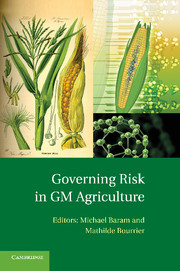Book contents
- Frontmatter
- Contents
- Preface
- Contributors
- 1 Governing Risk in GM Agriculture
- Part I Risk Governance and Public Discourse
- Part II Future Challenges
- 6 Coexistence and Traceability of GMOs in the Agro-Food Sector
- 7 The “Pharming” Challenge
- 8 GMO as a Sustainability Issue
- 9 Applying Safety Science to Genetically Modified Agriculture
- Index
- References
6 - Coexistence and Traceability of GMOs in the Agro-Food Sector
Published online by Cambridge University Press: 01 March 2011
- Frontmatter
- Contents
- Preface
- Contributors
- 1 Governing Risk in GM Agriculture
- Part I Risk Governance and Public Discourse
- Part II Future Challenges
- 6 Coexistence and Traceability of GMOs in the Agro-Food Sector
- 7 The “Pharming” Challenge
- 8 GMO as a Sustainability Issue
- 9 Applying Safety Science to Genetically Modified Agriculture
- Index
- References
Summary
Introduction and Regulatory Framework
The worldwide acreage of genetically modified (GM) plants is growing year by year and amounted to more than 114 million hectares in 2007 (ISAAA, 2008; James, 2005, 2006). In contrast to the globally growing use of GM plants in agriculture, the acceptance of GM food is still low in the European Union (EU) (Gaskell et al., 2006) as well as in Germany (Frank, 2004). In the opinion of most EU consumers there is nothing to gain by applying GMO ingredients but serious disadvantages may occur. Some of the often-mentioned concerns of EU consumers are negative long-term health and/or environmental impacts, the extreme difficulties of reversing GMO technology as soon as it becomes widespread, and a rising monopolization of huge seed and food processing companies resulting in a larger dependency of farmers as well as ethical concerns. Furthermore, the share of people thinking that it is useful to apply biotechnology to food production decreased in the recent years (Gaskell et al., 2006). It is interesting that there are significantly more consumers concerned about GM food than about medical applications of biotechnology (Frank, 2004; European Commission, 2002; Gaskell et al., 2006). In the case of GM food the high opposition of European consumers “is accompanied by perceptions of relatively high risk” (Gaskell et al., 2006) which is unacceptable for many EU consumers.
- Type
- Chapter
- Information
- Governing Risk in GM Agriculture , pp. 139 - 168Publisher: Cambridge University PressPrint publication year: 2010



